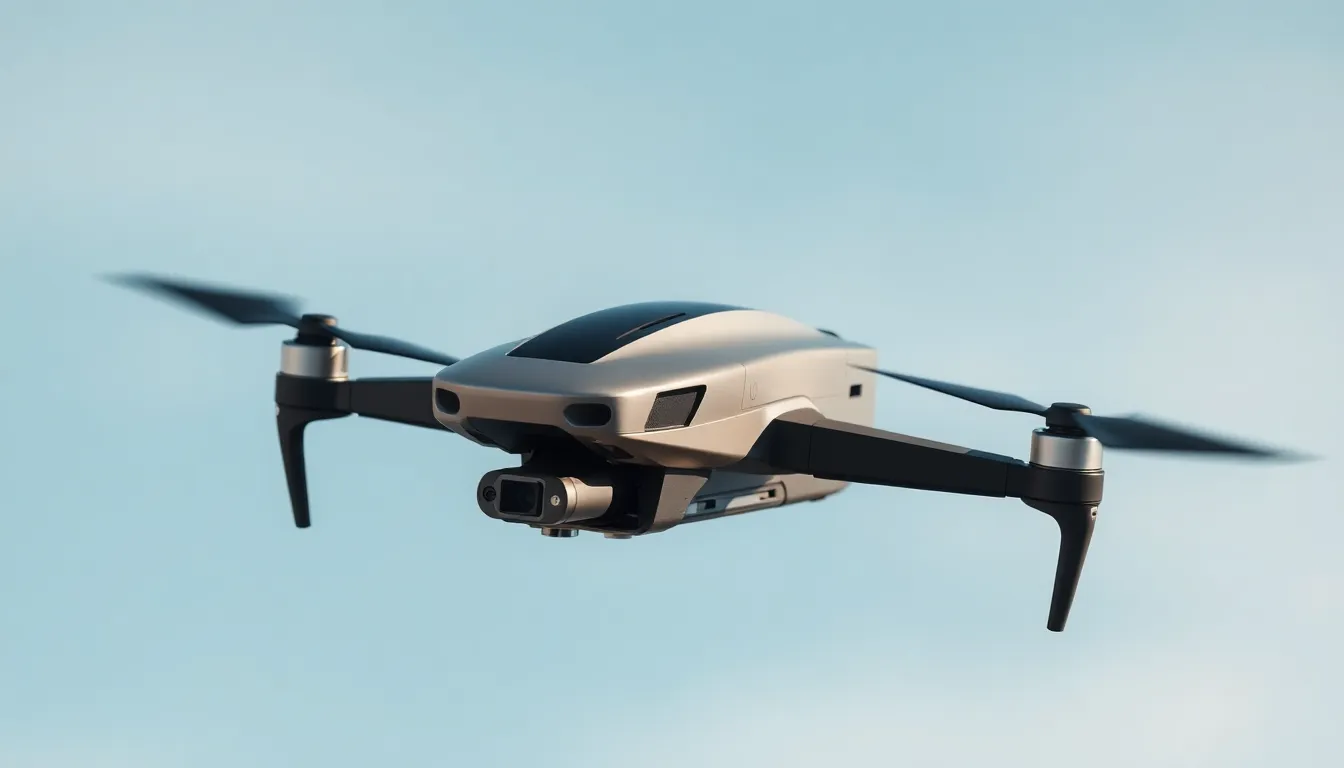Drones have taken to the skies like they own the place, zipping around with a swagger that would make even the fastest sports cars jealous. But just how fast can these high-flying gadgets really go? From leisurely neighborhood surveillance to racing competitions that make NASCAR look like a Sunday drive, drones are redefining speed in the aerial world.
Table of Contents
ToggleOverview of Drone Speed
Drones showcase a wide range of speeds depending on their design and purpose. Consumer drones typically fly at speeds between 15 to 50 miles per hour. Racing drones, however, can reach impressive velocities of up to 120 miles per hour, demonstrating advanced technology and aerodynamic designs.
Military drones exhibit even greater capabilities. The MQ-9 Reaper drone, for instance, can fly at speeds of around 300 miles per hour, making it suitable for surveillance and combat missions. High-speed options are not limited to military applications; many commercial drones are increasingly designed to enhance efficiency in delivery services, achieving speeds of up to 55 miles per hour.
When examining the factors that influence drone speeds, weight plays a significant role. Lighter drones tend to reach higher velocities more efficiently than their heavier counterparts. Additionally, battery life affects performance; faster speeds often lead to faster battery depletion. Some drone models incorporate advanced propulsion technology to maximize speed without sacrificing flight time.
As technology evolves, manufacturers focus on creating faster, more agile drones. Innovations in materials and aerodynamics continue to improve flight performance while maintaining stability. Drone enthusiasts and professionals increasingly utilize speed as a key metric when selecting a model for specific tasks, such as aerial photography, racing, or surveying.
Real-world applications highlight the importance of drone speed. In emergency situations, swift drone deployment can significantly impact response times. Moreover, in competitive racing, speed is essential, providing a thrilling experience for pilots and spectators alike. These advancements confirm that drones are changing the dynamics of speed in aerial applications.
Factors Affecting Drone Speed

Several factors determine how fast drones can fly. Understanding these elements provides insight into the performance capabilities of different models.
Drone Design and Build
Drone design significantly impacts speed. Aerodynamic shapes allow for smoother airflow, enhancing velocity. Lightweight materials contribute to speed increases by reducing drag. Frame designs, including propeller size and configuration, also affect how quickly a drone can maneuver. Engineers focus on creating efficient designs to optimize flight performance across various conditions.
Payload Capacity
Payload capacity plays a critical role in drone speed. Heavier payloads can slow drones due to increased weight. Every ounce affects lift and stability, which in turn impacts speed. Drones designed for racing typically have minimal payload limits to prioritize speed over carrying capacity. Understanding how payload affects speed helps in selecting the right drone for specific applications.
Battery Life and Power
Battery life and power output directly influence drone speeds. Higher speeds often lead to faster battery drain. Drones with stronger, more efficient batteries can maintain speed longer without performance loss. Manufacturers innovate to improve battery technology, allowing pilots to enjoy faster speeds during extended flights. Evaluating energy consumption patterns helps determine optimal speed settings for longer missions.
Types of Drones and Their Speeds
Drones come in various types, each designed for specific purposes and speed capabilities.
Consumer Drones
Consumer drones typically operate at speeds ranging from 15 to 50 miles per hour. Lightweight models, such as the DJI Mavic series, often reach these mid-range speeds effortlessly. Features like user-friendly controls and stabilization technology enhance the flying experience. Battery life directly impacts flight duration, as faster speeds may deplete power quickly. Many hobbyists enjoy using these drones for aerial photography and casual exploration due to their accessibility.
Racing Drones
Racing drones stand out with remarkable speeds, often exceeding 120 miles per hour. Designed specifically for speed and agility, models like the Fat Shark and Emax Hawk offer competitive edge in racing events. These drones prioritize lightweight construction and powerful motors, contributing to rapid acceleration. Pilots utilize advanced control systems to navigate through intricate courses with precision. Speed optimization becomes essential as racers push their limits in competitive environments.
Commercial Drones
Commercial drones achieve speeds of up to 55 miles per hour, making them efficient for various applications, including delivery and surveying. Companies like Amazon and DHL leverage these drones to enhance logistics and transport. Innovations in aerodynamic design and material technology support higher speeds while maintaining stability. In many cases, the balance between speed and payload capacity is crucial, as heavier loads may slow operations. Efficient battery management ensures that commercial drones maximize their speed during flights.
Record-Breaking Speeds in Drones
Some drones achieve astonishing speeds that redefine what aerial technology can accomplish. Racing drones stand out with their capability to exceed 120 miles per hour. Models like the Fat Shark and Emax Hawk exemplify this trend, designed for lightweight agility and powerful motors that enhance rapid acceleration. Pilots often navigate through tight courses, emphasizing the need for speed optimization in competitive racing.
Military drones, specifically the MQ-9 Reaper, reach impressive speeds around 300 miles per hour. This remarkable velocity supports both surveillance and combat missions, showcasing how speed enhances operational effectiveness. Commercial drones also contribute to the fast-paced logistics field, with speeds up to 55 miles per hour. Companies such as Amazon and DHL benefit from this efficiency, allowing quicker deliveries and improved service.
Weight and design greatly affect the maximum speeds of drones. Lighter models provide better velocity, while heavier payloads may slow operations. Battery life acts as another limiting factor; faster drones often experience quicker battery depletion. Innovations in materials and aerodynamics offer promising solutions, pushing the envelope of speed in drone technology.
Frame designs and propeller configurations influence maneuverability, which significantly impacts operational speed. These advancements in engineering continuously evolve drone capabilities, making them essential tools in emergency situations and competitive racing. The drive for greater speed shapes the future of aerial applications, highlighting the need for ongoing innovation in this dynamic field.
Future Trends in Drone Speed
Emerging technologies are pushing drones toward unprecedented speed capabilities. Innovations in battery efficiency and propulsion systems promise enhancements in flight performance. Faster motors and advanced aerodynamics significantly influence overall velocity.
In the coming years, racing drones are set to redefine competitive aerial sports. Next-generation models may exceed speeds of 150 miles per hour, as manufacturers focus on weight reduction and increased power. Lightweight materials like carbon fiber and advanced composites are becoming standard in these high-speed designs.
Military applications will likely see further advancements with drones such as the MQ-9 Reaper. The ability to reach speeds approaching 400 miles per hour can enhance tactical surveillance and combat capabilities. Streamlined designs and cutting-edge technology create a significant advantage in critical missions.
Commercial drones are experiencing speed increases as well. Companies targeting logistics and delivery sectors are enhancing their models to reach 65 miles per hour. These advancements mean faster delivery times and greater efficiency in transporting goods.
Regulatory frameworks are evolving alongside technological advancements. With increasing speeds, regulations will need to adapt to ensure safe airspace management. Coordination among stakeholders is crucial for maintaining safety standards as drone speeds increase.
As the pursuit for greater speeds continues, drone designers face unique challenges. Balancing speed with payload capacity remains crucial for successful operations. Future design innovations will prioritize both performance and stability, ensuring drones remain reliable tools for various applications.
Drones are redefining speed in the aerial landscape with impressive capabilities across various sectors. From consumer models to high-performance racing and military drones, the advancements in technology are remarkable. As innovations continue to evolve, the potential for even faster drones is on the horizon.
The balance between speed and payload capacity remains a critical consideration for manufacturers. Future developments in battery efficiency and propulsion will likely push the limits further, opening new possibilities for both commercial and recreational use. With regulations adapting to these advancements, the future of drone speed promises to be both exciting and transformative.


